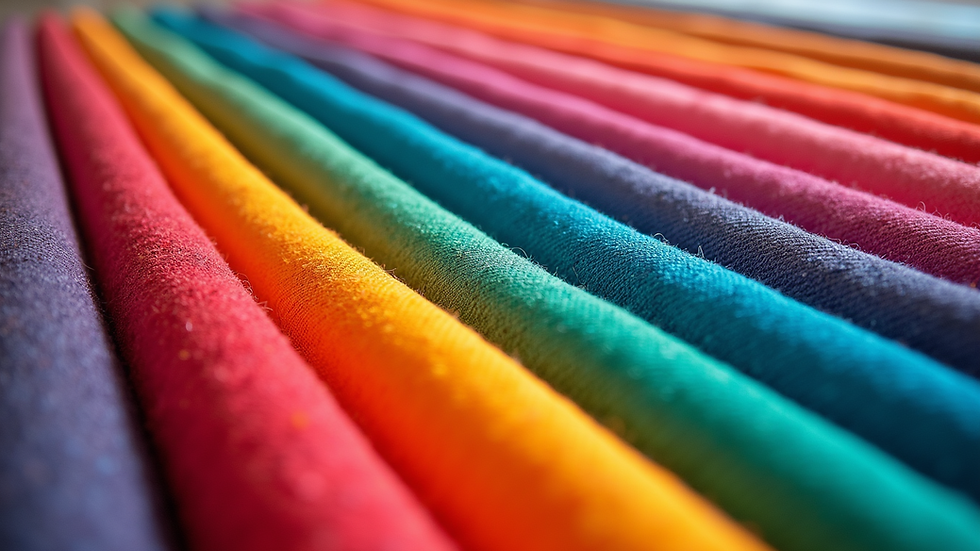Role of Color in Shaping Trends and Perceptions within the Textile Industry
- sknigamiiml
- Aug 20
- 4 min read
Color is a major player in the textile industry, shaping everything from consumer preferences to fashion trends. It holds extraordinary power to evoke emotions, convey messages, and influence purchasing decisions. Colour is the visual perception we experience when light reflects off objects and enters our eyes. It’s how our brains interpret different wavelengths of light—almost like nature’s way of painting the world for us.
The Psychology of Color
Here’s a quick breakdown:
· Scientifically: Colour is based on the wavelength of light. Red has a longer wavelength; violet, a shorter one.
· Visually: It's what we see—red, blue, green, etc.—thanks to receptors in our eyes called cones that respond to light.
· Perceptually: Colour can look different depending on lighting, surroundings, or even how your brain interprets it. (Ever seen that infamous blue/gold dress?)
Color psychology examines how colors impact human behavior and emotions. Understanding this psychology is critical for designers and marketers in the textile industry. Different shades evoke different feelings. For instance, studies show that blue is linked to calmness and trust, often seen in uniform designs to instill confidence. Red, on the other hand, is exciting and passionate, frequently used in campaigns to stimulate attention.
When designers select colors for textiles, they aim to elicit specific emotional responses. For example, a soft pastel palette, often featuring shades like baby blue or light pink, works well for children's clothing lines, as it evokes innocence and playfulness. Alternatively, bold and vibrant colors like electric green or hot pink may suit activewear, inspiring energy and motivation.
Color Trends in Fashion
Interestingly, not all creatures see colour the same way. Bees can see ultraviolet light, which humans can’t, and dogs perceive a more muted palette.
Color trends within the textile industry evolve based on cultural shifts, seasonal changes, and global events. Fashion weeks around the globe highlight the latest palettes that can define upcoming seasons.
For example, the Pantone Color Institute's annual "Color of the Year" profoundly influences designers and manufacturers. In 2023, Viva Magenta was chosen, a dynamic shade that symbolizes courage and a sense of renewed energy. Following this announcement, many brands began incorporating this intense hue into their collections, resulting in a surge in product offerings across various sectors, including clothing and home textiles.

Cultural Significance of Colors
Colors possess diverse meanings around the world and their significance can greatly influence the textile market. In Western cultures, white commonly represents purity and weddings, while in some Eastern cultures, it symbolizes mourning.
Designers must navigate these cultural nuances when crafting textiles for a global audience. For instance, a bright red dress that’s popular in China, where it signifies luck and happiness, might not resonate the same way in other locations, potentially leading to miscommunication and lost sales.
Brands that incorporate culturally relevant colors can foster deeper connections with consumers. For example, a company that designs textiles celebrating local traditions and colors can build loyalty and consumer engagement, showing respect for different cultural backgrounds.
The Role of Color in Branding
Color is a crucial component of branding, helping establish a brand's identity and distinguishing it from competitors. In textiles, brands frequently adopt specific color palettes to create a recognizable image.
For example, a brand that consistently utilizes earthy tones like olive green and terracotta may be perceived as eco-friendly and sustainable. In contrast, brands that favor brighter colors like fuchsia or turquoise are often viewed as youthful and energetic.
Maintaining consistency in color use aids consumer recall, allowing them to readily connect with the brand. This understanding of color’s role in branding is vital for textile companies aiming to strengthen their market presence.

Color and Consumer Behavior
The influence of color on consumer behavior is substantial. Research indicates that up to 85% of consumers make purchasing decisions based solely on color.
In textiles, making the right color choices can lead to increased sales and customer satisfaction. For instance, a clothing line featuring colors aligned with contemporary trends is more likely to attract shoppers compared to a line that uses outdated colors.
Color can also enhance the perceived value of products. Luxury brands often rely on rich, deep colors, such as navy or burgundy, to evoke exclusivity and sophistication. Meanwhile, budget-friendly brands may lean toward bright and playful colors to appeal to a broader audience.
The Future of Color in Textiles
As the textile industry continues to grow and change, so will the role of color. Advancements in technology now give designers access to a wider array of colors and materials, presenting new avenues for creativity and innovation.
Sustainability is a rising concern shaping color choices. With more consumers prioritizing eco-friendliness, there is a growing demand for natural dyes and sustainable coloring practices. This trend may lead to a resurgence of earthy tones and organic colors that emphasize a commitment to the environment.
Final Thoughts on Color’s Influence
The role of color in the textile industry is essential. It influences consumer behavior, shapes fashion trends, and impacts marketing strategies significantly.
As designers and brands navigate color psychology, cultural meanings, and consumer preferences, adaptability and creativity will remain key. By understanding the vital role of color, the textile industry can continue flourishing, producing products that resonate deeply with consumers.
In a world rich with color, its impact on textiles will only continue to expand, ensuring that it remains an integral part of design and marketing strategies.




Comments